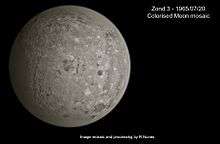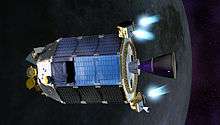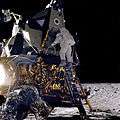Zond 3
| Mission type | Planetary Science | ||||||||||||||||||
|---|---|---|---|---|---|---|---|---|---|---|---|---|---|---|---|---|---|---|---|
| Operator | Soviet Union | ||||||||||||||||||
| COSPAR ID | 1965-056A | ||||||||||||||||||
| SATCAT № | 1454 | ||||||||||||||||||
| Website | Zond 3 on NSSDC Master Catalog | ||||||||||||||||||
| Spacecraft properties | |||||||||||||||||||
| Manufacturer | OKB-1 | ||||||||||||||||||
| Launch mass | 960 kg (2,120 lb) | ||||||||||||||||||
| Start of mission | |||||||||||||||||||
| Launch date | 14:38, July 18, 1965--> | ||||||||||||||||||
| Rocket | SL-6/A-2-e | ||||||||||||||||||
| End of mission | |||||||||||||||||||
| Last contact | March 1966 | ||||||||||||||||||
| Orbital parameters | |||||||||||||||||||
| Reference system | Heliocentric | ||||||||||||||||||
| Semi-major axis | 1 AU | ||||||||||||||||||
| Eccentricity | 0.2683 | ||||||||||||||||||
| Perihelion | 0.9 AU | ||||||||||||||||||
| Apohelion | 1.56 AU | ||||||||||||||||||
| Inclination | 0.5° | ||||||||||||||||||
| Period | 500 days | ||||||||||||||||||
| Flyby of Moon | |||||||||||||||||||
| Closest approach | July 20, 1965 | ||||||||||||||||||
| Distance | 9,200 km (5,700 mi) | ||||||||||||||||||
| |||||||||||||||||||
Zond 3 was a 1965 space probe intended to be sent toward Mars[1] as a spacecraft test. It was a member of the Soviet Zond program sharing designation Zond, while being part of Mars 3MV project. It was unrelated to Zond spacecraft designed for manned circumlunar mission (Soyuz 7K-L1). Zond 3 completed a successful Lunar flyby, taking a number of good quality photographs for its time. It is believed that Zond 3 was initially designed as a companion spacecraft to Zond 2 to be launched to Mars during the 1964 launch window. The opportunity to launch was missed, and the spacecraft was launched on a Mars trajectory as a spacecraft test, even though Mars was no longer attainable.
History
Zond 3 was a repeat of a mission that failed in late 1963 intended to test communication at distances equivalent to the distances experienced by Mars and Earth.[2] It passed by Earth's moon, the Moon, in 33 hours and communication ended when it was at a distance of 150 million kilometers from the Earth.[3] The spacecraft was a 3MV-4 type and launched into space on a 8K78 Molniya rocket on July 18, 1965.[4] It operated for 228 days, roughly equivalent to the time needed to survive a journey to Mars and exceeding that needed for Venus.[4]
The Zond 3 took pictures of the Moon on film which were then scanned and returned by radio signal back to Earth; it took 25 exposures in visible light and three more for an ultraviolet spectrometer.[4] The images it took could be re-transmitted, and the most distant re-transmission was on October 23, 1965 at a distance of 31.5 million km from the Earth.[4]
Spacecraft design
The spacecraft design was similar to Zond 2, in addition to the imaging equipment it carried a magnetometer, ultraviolet (0.25 to 0.35 micrometre and 0.19 to 0.27 micrometre) and infrared (3 to 4 micrometre) spectrographs, radiation sensors (gas-discharge and scintillation counters), a radiotelescope and a micrometeoroid instrument. It also had an experimental ion engine.
Mission

The spacecraft, a Mars 3MV-4A, was launched from a Tyazheliy Sputnik (65-056B) earth orbiting platform towards the Moon and interplanetary space. The spacecraft was equipped with an f/106 mm camera and TV system that provided automatic inflight film processing. On July 20 lunar flyby occurred approximately 39 hours after launch at a closest approach of 9200 km. 23 photographs and 3 ultraviolet spectra of very good quality were taken of the lunar farside from distances of 11,570 to 9960 km over a period of 68 minutes. The photos covered 19,000,000 km² of the lunar surface. Zond 3 proceeded on a Mars trajectory, but not at a time when planetary encounter would occur. To test telemetry, the images were rewound and transmitted at 2.2 million km, 31.5 million km and possibly again at greater distances, thus proving the ability of the communications system. The subsequent transmissions were also at a higher data rate.[5] The mission was ended and radio contact ceased when it was at a distance of 150 million km.
This article was originally based on material from NASA (NSSDC) information on Zond 3
References
- ↑ Brian Harvey (17 August 2007). Soviet and Russian Lunar Exploration. Springer Science & Business Media. pp. 82–. ISBN 978-0-387-73976-2.
- ↑ Zond 3: First to See Moon's Far Side on the Way to MarsJul 18, 2013 01:49 PM ET by Amy Shira Teitel
- ↑ Zond 3: First to See Moon's Far Side on the Way to MarsJul 18, 2013 01:49 PM ET by Amy Shira Teitel
- 1 2 3 4 The mission of Zond 3 by Andrew J. LePage
- ↑ Teitel, Amy Shira. "Zond 3: First to See Moon's Far Side on the Way to Mars". Discovery News. Discovery Communications. Retrieved 19 July 2013.
External links
| Preceded by Zond 2 |
Zond program (interplanetary) | Succeeded by None |


